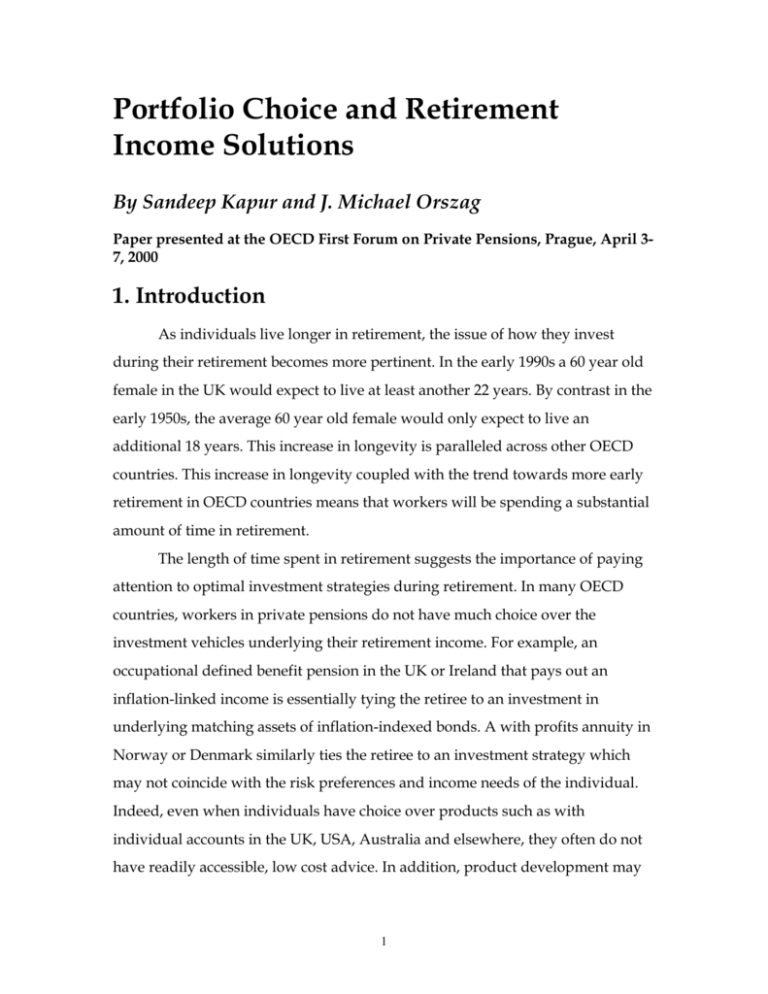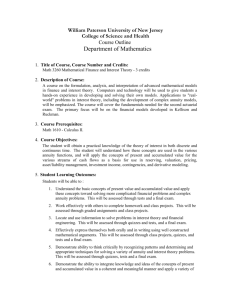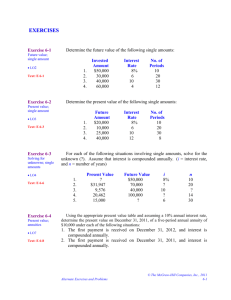Portfolio Choice and Retirement Income Solutions
advertisement

Portfolio Choice and Retirement Income Solutions By Sandeep Kapur and J. Michael Orszag Paper presented at the OECD First Forum on Private Pensions, Prague, April 37, 2000 1. Introduction As individuals live longer in retirement, the issue of how they invest during their retirement becomes more pertinent. In the early 1990s a 60 year old female in the UK would expect to live at least another 22 years. By contrast in the early 1950s, the average 60 year old female would only expect to live an additional 18 years. This increase in longevity is paralleled across other OECD countries. This increase in longevity coupled with the trend towards more early retirement in OECD countries means that workers will be spending a substantial amount of time in retirement. The length of time spent in retirement suggests the importance of paying attention to optimal investment strategies during retirement. In many OECD countries, workers in private pensions do not have much choice over the investment vehicles underlying their retirement income. For example, an occupational defined benefit pension in the UK or Ireland that pays out an inflation-linked income is essentially tying the retiree to an investment in underlying matching assets of inflation-indexed bonds. A with profits annuity in Norway or Denmark similarly ties the retiree to an investment strategy which may not coincide with the risk preferences and income needs of the individual. Indeed, even when individuals have choice over products such as with individual accounts in the UK, USA, Australia and elsewhere, they often do not have readily accessible, low cost advice. In addition, product development may 1 be limited by tax regulations or the slowness of provider product innovation. In the UK, for instance, about 85% or so of individuals purchase a simple level annuity when they retire with a personal pension. Yet, there is a substantial equity premium of equity over bonds which has been estimated at roughly 6% for the UK and the US. This equity premium suggests that perhaps there is more room for equity-linked retirement income solutions. Bank of England 25 yr. rate Consol Top Annuity Rate 5th Best Annuity Rate 15 13 Yield 11 9 7 5 12/23/88 5/7/90 9/19/91 1/31/93 6/15/94 10/28/95 3/11/97 7/24/98 Date Figure 1: Male Annuity Rates in the UK (65 year old level annuity rates) By an annuity, we mean a financial instrument which involves full capital sacrifice on the death of the annuitants. When comparing investments, there is also what we term an annuity premium.1 . Indeed, if we think of annuities as just providing for income in retirement, the economist Yaari showed in 1965 that 1 This is more commonly referred to as mortality drag. 2 annuities always do better than the underlying investment vehicle as long as administrative costs and selection effects are not too strong.2 Figure 1 plots the highest- and fifth-highest level annuity yield (or payment as a fraction of initial premium) for 65-year-old men against returns on some long-term fixed income securities that proxy the underlying investment vehicles for insurance companies issuing level annuities. There is clearly a significant annuity premium as long as an individual wants only income in retirement. This premium is not surprising as it arises from the capital sacrifice. The annuity premium increases rapidly with age as shown in Fig. (2) which plots level annuity yields as a function of age for level annuities in the UK on May 12, 2000.3 We note that the empirical annuity premium in Fig. (2) may be significantly lower than an annuity premium calculated using population mortality. Differences are due to adverse selection, socioeconomic selection and some cost/profit loadings. Because they are effectively commoditized and have low servicing costs, gilt-backed annuities tend to have low commissions and the better quoted annuity rates have relatively low implied profit margins. Nevertheless, rational individuals will make decisions based on marginal yields from annuities and any selection or cost loadings on annuity serve to delay the annuity purchase decisions of a rational investor. M.E. Yaari. On the consumer’s lifetime allocation process. Review of Economic Studies, 5:304–317, 1965. 3 These are the top standard rates on the market, payable monthly in advance without guarantee. Data is for open market options from The Research Department’s RateTracker. 2 3 1 3 M a l e F e m a l e Yield 1 1 9 7 5 0 5 5 6 0 6 5 7 0 A g e Figure 2: Age structure of annuity rates on May 12, 2000 for men and women. This paper focuses on the optimal portfolio strategies of individuals in retirement where individuals can invest in assets of different risk classes and levels of capital sacrifice. The first section presents a basic model and the second section expands on this with a more complex, continuous time model. One key result of the second section is that when suitable equity-linked annuities are not available, individuals wait to annuitise in order to capture the higher returns from equity. However, because the annuity premium is rising with age and the equity premium is not, individuals focused on income in retirement will typically shift their portfolio towards fixed-income annuities as they become older. 2. Basic Concepts To illustrate the basic concepts, we develop a simple model of annuitisation and retirement investment strategy. Our model is a two period model in which 4 individuals can choose to invest in annuities and an underlying fundamental security. We define: R return on fundamental security R d return on insurance security if individual dies R a return on insurance security if individual lives (1.1) We also define: A0 initial level of assets Ad assets in estate if individual dies Aa assets available if individual lives portfolio share of insured security (1.2) Using our definitions and, for simplicity of notation, letting our returns correspond to capital plus appreciation: Ad R d (1 ) R A0 (1.3) Aa R a (1 ) R A0 (1.4) The simplest form of life insurance involves no surrender value if the individual is alive so that R a 0 . On the other hand, a pure annuity involves full surrender of capital if the individual dies so that R d 0 . If we consider an insurance company issuing annuities and investing the proceeds in a fundamental security, they have expected profits: q R (1 q )( R R a ) c A0 5 (1.5) where c are the costs of the insurance company. Individuals die with a probability q and in this case the insurance company makes a profit because it has invested in a security which yields R but has sold a pure annuity and hence has no liability to make payments. On the other hand, if the individual lives (which occurs with probability 1 q ), the insurance company needs to pay out R a which is at least partially offset by its investment income. If the profit loading per unit of assets managed by the insurer is , then the return on an annuity is: Ra R (c ) 1 q (1.6) which is bigger than the return on the fundamental security as long as: qR (c ) (1.7) or that the death probability is sufficiently high to cover the extra administrative cost and profit loadings of the insurers.4 The extra benefit from an annuity in terms of higher income is hence largest when death rates are higher (e.g., age is older) and annuities may indeed not be profitable to underwrite at younger ages. In general, though, one expects that annuities will yield higher income in retirement for the individual than the returns on the underlying investment vehicle. We now consider optimal portfolio choice of the individual in our simple model. We consider only the case here where the individual has no utility from estate income and hence cares only about income in retirement. The individual can The idea that annuities are the best vehicle for retirement income dates to Yaari(1965). M.E. Yaari. On the consumer’s lifetime allocation process. Review of Economic Studies, 5:304–317, 1965. 4 6 choose between investing in annuities or the fundamental security. The expected utility of the individual is: V (1 q) E (U a ( Aa )) (1.8) where U a is the utility of the individual from retirement income. Clearly as long as (1.9) holds, the individual will want to put his entire sum of assets into annuities as they yield more in terms of retirement income. 3. A Continuous Time Model The previous section suggested that annuities provided the best solution for retirement income. However, this result only holds if there are annuities available which match the desired asset allocation of the individual. In this section, we consider a portfolio choice problem where there are only bondbacked annuities and equity. If the individual cares only about income in retirement, bond-backed annuities dominate bonds and hence need not be considered. However, equity yields higher returns than bonds and therefore may be a good investment for individuals. We look at a continuous time model of this type in another paper.5 We let Be the age of a retired investor with no earned labour income. An investor aged x is assumed to die with some probability ( x ) .6 Equities yield a mean return of but this return is random with standard deviation . This is compared with annuities which yield r ( x) to those who live (where r is the rate of return on bonds). 5 Sandeep Kapur and J Michael Orszag, A Portfolio Approach to Investment and Annuitization During Retirement. Centre for Pensions and Social Insurance, Research Report, 99-05, May 1999 (c.f., http://www.pensions-research.org/papers/papers1999.htm). Our model is an extension for annuities of the classical Merton model of portfolio choice: Robert Merton, “ Lifetime portfolio selection under uncertainty: The continuous time case”, Review of Economics and Statistics, 51:247–257, 1969. 6 We use ( x ) instead of q as in Sec. 2 because time is continuous. 7 With perfect markets, the payment structure of the annuity is not relevant as individuals who desire different payment structures can borrow money each period at interest rate r while paying for life assurance to secure the principal at rate ( x ) 7 For the case of constant relative risk aversion, we found that the optimal fraction in equity is w( x) 1 Max( r ( x), 0) 2 (1.10) where is the coefficient of relative risk aversion. Significantly, this model predicts a critical age at which an individual ceases to hold any equity. This age does not depend on the volatility of markets or risk aversion; the swtiching age only depends on the difference between the equity premium and annuity premium the excess return to annuities because of cohort mortality.8 While the cross-over age does not depend on relative risk aversion, the speed of approach to the cross-over age is dependent on risk aversion. In Fig. 3, we show the optimal asset allocation for UK insured men and women using the latest pensioner mortality tables assuming relative risk aversion of 2 an equity premium of 7% and a standard deviation of equity returns of 0.25. A typical 80 year old female life office pensioner with moderate risk aversion would still be holding about 15% of her assets in equity.9 In practice, one impact of imperfect markets may be more upfront payment of annuities and this is one potential reason most of the UK market involves level annuities. 7 The relevant mortality rate is that charged by the insurance company issuing the annuity. Private information about individual mortality will influence consumption behaviour but not asset allocation with constant relative risk aversion utility.} 9 Portfolio share here includes the reserves held by the insurance company. Bequest motives may lead to higher equity shares, depending on risk aversion about the size of the bequest. 8 8 0.5 Fraction of Portfolio in Equity Male Female 0.4 0.3 0.2 0.1 0.0 60 65 70 75 80 85 Age Figure 3: The Share of Equity in the Optimal Portfolio 4. Conclusions This paper has reviewed the issue of investment choice during retirement. Many private pension plans were designed in an era where workers lived for much shorter periods of time in retirement so that it was more reasonable to have fixed benefit designs with little control for the pensioner over investments. Our paper has pointed to the potential welfare benefits for the individual from more innovative retirement income products. In addition, allowing better-off individuals with more flexibility to invest in retirement could lessen the strain on the solvency margins of pension funds and life insurers from a heavy reliance on guaranteed income products throughout OECD countries. 9









